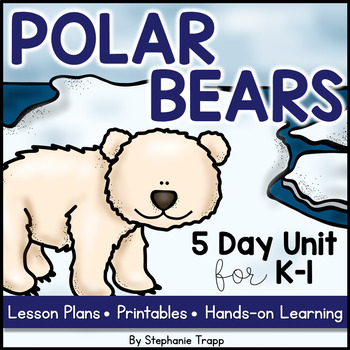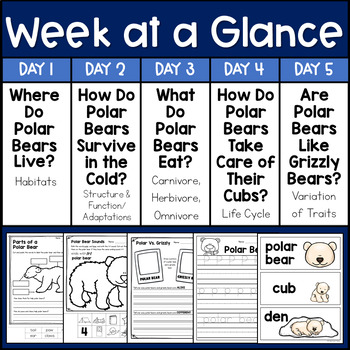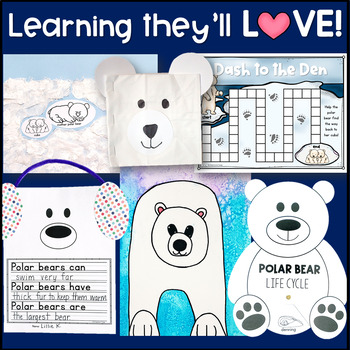Polar Bear Unit for Kindergarten and First Grade
- PDF
What educators are saying
Description
What do polar bears eat? Where do they live? Find out the answers to these questions and more during this polar bear unit for kindergarten and first grade! The week-long comprehensive unit includes detailed daily lesson plans with literature suggestions. It incorporates science, reading, writing, math, handwriting and art. It also includes a STEAM activity and links to videos that complement the unit study.
Click on the PREVIEW to read each lesson plan, see the Week-at-a-Glance planning sheet, as well as examples of printables and art projects.
Teacher Features You’ll Love:
- Detailed daily lesson plans
- Week-at-a-glance planning guide
- Key concepts and objectives
- Extensive literature list
- Video links and QR codes
- Activity directions and printable templates
What’s Covered in the Unit?
Day 1: Where do Polar Bears Live? (Habitats)
- Home sweet home habitat comparison
- Begin polar bear book (two options; students add to it each day)
- Arctic opinion writing
Day 2: How Do Polar Bears Survive in the Cold? (Structure & Function/Adaptations)
- Label parts of a polar bear
- Warm in winter writing
- Blubber experiment
- Add to polar bear book
Day 3: What Do Polar Bears Eat? (Carnivores, Herbivores, Omnivores)
- What’s for Lunch? writing
- Food chain activity
- Add to polar bear book
Day 4: How Do Polar Bears Take Care of Their Cubs? (Life Cycle)
- Polar Bear Den STEAM activity
- Polar Bear Life Cycle Craft
- Growing Up writing
- Add to polar bear book
Day 5: Are Polar Bears Like Grizzly Bears? (Variation of Traits)
- Polar Vs. Grizzly Activity
- Easy, no-bake polar bear cookies
- Polar bear writing craft
- Polar bear directed drawing
Math Connections:
- Math game for a math center
- Ordering numbers least to greatest
- Counting
- Place value: tens and ones
- Addition to 10, 20 and 100
- Missing addends
- Subtraction within 10, 20 and 100
- Making ten
- Comparing numbers: larger/smaller and with >, <, =
- Graphing
- Measuring
- Word problems
Literacy Connections:
- Polar bear word wall
- “A Cub in the Tub” emergent reader
- Beginning, medial and ending letter sounds
- Beginning and ending blends
- Rhyming
- Read and write cvce words with long i
- Punctuation
- Verbs
- Homophones
- Polar bear report writing
- Polar Bears at Play writing activity
- Polar Bear in the Pool writing activity
Questions? Feel free to click on the "Q & A" tab to contact me here or email me at primarythemepark@gmail.com.
Find more cross-curricular units for K-1 HERE.
Thanks so much for stopping by!





